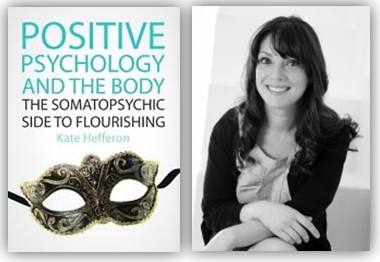
Book Review
Author: Dr Kate Hefferon - first published in 2013 by Open University Press.
Positive Psychology and Body: The Somatopsychic Side to Flourishing
Dr Kate Hefferon is a Chartered Psychologist and was a senior lecturer at the University of East London (when this article was first published in 2016). Her PhD thesis was on the experience of Post-Traumatic Growth (PTG) amongst breast cancer survivors and the role of the body and physical activity in the recovery and growth process.
Her fascination with the human body started years ago when she was a professional dancer and continued into her university education, leading to MSc in Performance Psychology and a PhD in psychology. Her dance background and her focus on sports and physical performance led to her working with top sports scientists, internationally renowned dance companies, and top Canadian performers.
A couple of Dr Hefferon’s colleagues, namely Professor Angela Clow from the University of Westminster (London) and Dr Michael Pluess from the Queen Mary University of London, Co-wrote the second and fourth chapters of the book with her.
The book “Positive Psychology and the Body: The Somatopsychic Side to Flourishing” aims to provide an overview of the huge quantity of scientific research into the relationship between our bodies and experiences of momentary pleasure or long-term feelings of meaning and self-actualisation. The book is a critical reflection of the fact that the role of the body has been mostly overlooked in positive psychology. It’s also a review of the related literature of a wide range of topics such as physical activity, interpersonal touch, sexual behaviours, nutrition, etc.
The book has a highly academic tone and structure that make it a suitable textbook for positive psychology students and enthusiasts, and an excellent reference book for researchers.
Throughout the book, there are text boxes designed to create additional depth and dimension by getting the reader to think and critically reflect on the topic of discussion. Some of these text boxes provide additional information or real-life case studies that enhance understanding and bring practicality to the topics.
She also has introduced quite a few measurement tools, questionnaires and scales that together make the book a good “workbook” for positive psychology practitioners. Besides, it contains many suggested resources and references that help researchers and avid followers of positive psychology take their studies further.
Dr Hefferon explored the concept of flourishing and the history behind the body in psychology to show the importance of experiencing hedonic and eudaimonic wellbeing. She paid close attention to the workings of the body that affect well-being. She discussed emotions, facial expressions, sleep, cortisol, glucose and other components of the body. What's more, her journey takes the reader to the brain's functions and how its various parts interact and affect well-being. The role of intimacy, love and sexuality in wellbeing is another focus of her investigation that covers the bonding power of Oxytocin.
The role of genetics in flourishing is a new interesting topic that gives us a taste of Behavioural Genetics and Molecular Genetics. Dr Hefferon discussed the genetic component of well-being and showed that some people are more affected by negative and positive experiences than others. Likewise, she talked about the concept of “Positive Health”, which is a branch of Health Psychology. Positive health is about getting well, improving and even flourishing after an illness.
Dr Hefferon looks at the body as a vehicle for change and transformation after a trauma. She defines Posttraumatic Growth (PTG) as a phenomenon of exceeding the previous levels of functioning. PTG happens when changes caused by a traumatic experience move a person to a higher psychological and physiological functioning level. She also talks about “Terror Management” theory, the concept of “Mortality Salience”, and how people might reflect on their mortality. These discussions lead to the many ways people can reclaim their bodies after a serious sickness or trauma.
Talking about physical health wouldn’t be complete without taking the role of a balanced nutritional diet and physical exercise into account. Dr Hefferon looks at the social trends, nutritional habits and barriers to exercise that play an important role in the physical and psychological wellbeing of society.
The book's scope is so wide that it includes a chapter about aesthetics, beauty and adornment. She has discussed the historical link between fashion, makeup and wellbeing and extended the discussion to tattooing, piercing and scarification (cutting designs, pictures, or words into the skin). Dr Heffron does not condemn plastic surgery or body modifications as they could enhance hedonic and eudaimonic aspects of wellbeing.
Dr Hefferon ends her book with a chapter on Body Therapies. She has introduced Dance Therapy, Mindfulness, Yoga, Massage, Alexander Technique, Biofeedback, Psychotherapy Exercises and Progressive Muscle Relation. She has shown how different body-based therapies can enhance connectivity with the body and promote wellbeing.
To sum up my review, I like to use Dr Biswas-Diener’s words, who said, “This book has it all: from sex to genetics to illness, Hefferon brings an expert review of research, clear advice and fresh thinking.